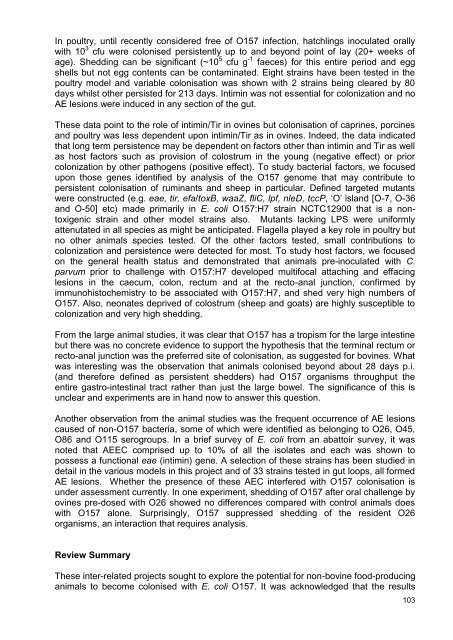Review of the Food-borne Zoonoses Research ... - ARCHIVE: Defra
Review of the Food-borne Zoonoses Research ... - ARCHIVE: Defra
Review of the Food-borne Zoonoses Research ... - ARCHIVE: Defra
You also want an ePaper? Increase the reach of your titles
YUMPU automatically turns print PDFs into web optimized ePapers that Google loves.
In poultry, until recently considered free <strong>of</strong> O157 infection, hatchlings inoculated orally<br />
with 10 3 cfu were colonised persistently up to and beyond point <strong>of</strong> lay (20+ weeks <strong>of</strong><br />
age). Shedding can be significant (~10 5 cfu g -1 faeces) for this entire period and egg<br />
shells but not egg contents can be contaminated. Eight strains have been tested in <strong>the</strong><br />
poultry model and variable colonisation was shown with 2 strains being cleared by 80<br />
days whilst o<strong>the</strong>r persisted for 213 days. Intimin was not essential for colonization and no<br />
AE lesions were induced in any section <strong>of</strong> <strong>the</strong> gut.<br />
These data point to <strong>the</strong> role <strong>of</strong> intimin/Tir in ovines but colonisation <strong>of</strong> caprines, porcines<br />
and poultry was less dependent upon intimin/Tir as in ovines. Indeed, <strong>the</strong> data indicated<br />
that long term persistence may be dependent on factors o<strong>the</strong>r than intimin and Tir as well<br />
as host factors such as provision <strong>of</strong> colostrum in <strong>the</strong> young (negative effect) or prior<br />
colonization by o<strong>the</strong>r pathogens (positive effect). To study bacterial factors, we focused<br />
upon those genes identified by analysis <strong>of</strong> <strong>the</strong> O157 genome that may contribute to<br />
persistent colonisation <strong>of</strong> ruminants and sheep in particular. Defined targeted mutants<br />
were constructed (e.g. eae, tir, efa/toxB, waaZ, fliC, lpf, nleD, tccP, ‗O‘ island [O-7, O-36<br />
and O-50] etc) made primarily in E. coli O157:H7 strain NCTC12900 that is a nontoxigenic<br />
strain and o<strong>the</strong>r model strains also. Mutants lacking LPS were uniformly<br />
attenutated in all species as might be anticipated. Flagella played a key role in poultry but<br />
no o<strong>the</strong>r animals species tested. Of <strong>the</strong> o<strong>the</strong>r factors tested, small contributions to<br />
colonization and persistence were detected for most. To study host factors, we focused<br />
on <strong>the</strong> general health status and demonstrated that animals pre-inoculated with C.<br />
parvum prior to challenge with O157:H7 developed multifocal attaching and effacing<br />
lesions in <strong>the</strong> caecum, colon, rectum and at <strong>the</strong> recto-anal junction, confirmed by<br />
immunohistochemistry to be associated with O157:H7, and shed very high numbers <strong>of</strong><br />
O157. Also, neonates deprived <strong>of</strong> colostrum (sheep and goats) are highly susceptible to<br />
colonization and very high shedding.<br />
From <strong>the</strong> large animal studies, it was clear that O157 has a tropism for <strong>the</strong> large intestine<br />
but <strong>the</strong>re was no concrete evidence to support <strong>the</strong> hypo<strong>the</strong>sis that <strong>the</strong> terminal rectum or<br />
recto-anal junction was <strong>the</strong> preferred site <strong>of</strong> colonisation, as suggested for bovines. What<br />
was interesting was <strong>the</strong> observation that animals colonised beyond about 28 days p.i.<br />
(and <strong>the</strong>refore defined as persistent shedders) had O157 organisms throughput <strong>the</strong><br />
entire gastro-intestinal tract ra<strong>the</strong>r than just <strong>the</strong> large bowel. The significance <strong>of</strong> this is<br />
unclear and experiments are in hand now to answer this question.<br />
Ano<strong>the</strong>r observation from <strong>the</strong> animal studies was <strong>the</strong> frequent occurrence <strong>of</strong> AE lesions<br />
caused <strong>of</strong> non-O157 bacteria, some <strong>of</strong> which were identified as belonging to O26, O45,<br />
O86 and O115 serogroups. In a brief survey <strong>of</strong> E. coli from an abattoir survey, it was<br />
noted that AEEC comprised up to 10% <strong>of</strong> all <strong>the</strong> isolates and each was shown to<br />
possess a functional eae (intimin) gene. A selection <strong>of</strong> <strong>the</strong>se strains has been studied in<br />
detail in <strong>the</strong> various models in this project and <strong>of</strong> 33 strains tested in gut loops, all formed<br />
AE lesions. Whe<strong>the</strong>r <strong>the</strong> presence <strong>of</strong> <strong>the</strong>se AEC interfered with O157 colonisation is<br />
under assessment currently. In one experiment, shedding <strong>of</strong> O157 after oral challenge by<br />
ovines pre-dosed with O26 showed no differences compared with control animals does<br />
with O157 alone. Surprisingly, O157 suppressed shedding <strong>of</strong> <strong>the</strong> resident O26<br />
organisms, an interaction that requires analysis.<br />
<strong>Review</strong> Summary<br />
These inter-related projects sought to explore <strong>the</strong> potential for non-bovine food-producing<br />
animals to become colonised with E. coli O157. It was acknowledged that <strong>the</strong> results<br />
103

















